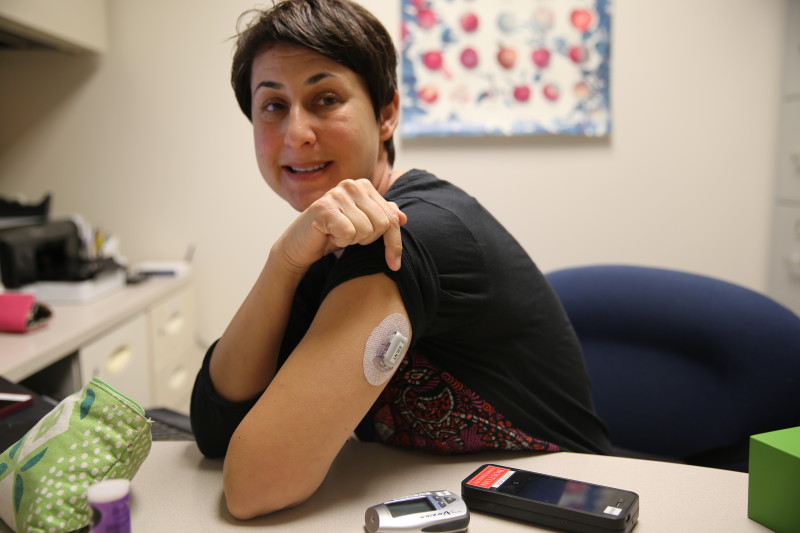People With Diabetes and Prediabetes
Continuous glucose monitoring was originally developed specifically for people with type 1 diabetes, in order to monitor their glucose levels at all times -- not just periodically with a prick of a fingertip.
This population is obviously the most in need, given that inadequate production of insulin results in highly variable blood sugar values. Continuous glucose monitors have proven to be extremely useful for this patient population. The technology has given both people with diabetes and their doctors an ability to fine-tune an insulin-dosing strategy to minimize blood sugar fluctuations.
Some individuals with type 2 diabetes are given CGMs as well. On occasion, they are used only temporarily in order to gain some immediate insight into daily blood sugar fluctuations. Others use such continuous monitors in the long-term to support a blood glucose management program.
But people with diabetes may have some challenges with today's continuous blood sugar monitors.
One of the main problems with the current technology is that it is often difficult to obtain, even with comprehensive health insurance. I've heard from people with type 1 diabetes, who have a difficult time getting their hands on a continuous monitor. And many doctors are overburdened with excessive paperwork to request that a patients' insurer cover the cost of a CGM and/or insulin pump.
Existing CGMs have come a long way, and now provide wireless blood glucose sensing that can be interpreted on a handheld mobile device.
Despite this, many users have told me that the devices feel pseudo-bionic. On one side of their abdomen sits a sensor that reads glucose on five-minute intervals and then transmits that data to a handheld wireless receiver; on the other side sits an insulin pump insertion site that is physically connected to the insulin pump via clear tubing. Many people with Type 1 Diabetes become frustrated with these devices and insertion sites, which adds to the overall strain of living with diabetes.
The cost of the device can also be prohibitive for many people with diabetes. Assuming that insurance covers the handheld receiver, each sensor can cost between $10 and $15 after insurance coverage, and last between three and five days. Over the course of a month, this can easily add up to over 100 dollars.
Fortunately, companies like Sano are paving the way for a more advanced, less invasive technology. All the user has to do is wear a clear adhesive strip (similar to a clear band-aid) and microneedles gain access to interstitial fluid. The strip measures concentrations of various metabolites including glucose, then wirelessly transmits this information to a users' smartphone or smartwatch.
In my opinion, this new type of CGM may push existing technology out of the market, because it breaks down many barriers to entry including cost, insurance coverage and the need for an external peripheral device.
Recreational and Professional Athletes
The second population of individuals that I believe will strongly benefit from CGM technology are recreational and professional athletes. Endurance athletes in particular (runners, swimmers, cyclists and triathletes) will benefit most, as the technology provides them with insight into blood glucose patterns they can then use to develop an optimal fueling strategy for long events.
One of the main difficulties facing endurance athletics is understanding exactly how much food to eat and at what times to eat. Many athletes spend a significant amount of mental energy optimizing their food intake strategy in order to avoid "bonking" during a race.
Unlike people with diabetes who experience large fluctuations in blood glucose throughout the day, non-diabetic individuals experience small fluctuations. A perfectly functioning pancreas can control blood glucose throughout the day. But for an athlete, understanding how these small changes in blood glucose affect athletic performance is invaluable.
Understanding one's current blood glucose value as well as the magnitude and direction of change can make the difference between a good performance and a great performance. Athletes that are privy to this information in real-time can make decisions that can drastically affect their immediate performance and their recovery as well.
Medical Professionals and Coaches
The third group of individuals who can leverage continuous blood sugar devices include medical professionals, such as doctors, nurses, hospice care providers, as well as nutritionists, fitness coaches and professional sports coaches.
There are many companies currently working on wireless systems to provide doctors with real-time or pseudo-real-time information about the daily glucose patterns of their patients. When given access to this information, a doctor can modify an individual's insulin dosing strategy, exercise regimen or medication strategy more frequently than if they waited for the patient to return for a follow-up visit. In this way, doctors and medical professionals can make faster decisions to benefit their patients rather than having to wait an average of three months between in-person appointments.
One of the main complaints that I hear from other people with diabetes is that they don't trust their doctors anymore. The reason for this is simple: In a 15 minute-long appointment, a doctor is generally incapable of analyzing large quantities of blood sugar data in order to make an intelligent and progressive set of decisions to benefit the patient.
As a result, many patients with diabetes feel alone and helpless, having to wait multiple months for another anti-climactic appointment. Those that are ambitious will make modifications themselves, or seek advice from other people with diabetes, support groups or nutritionists like myself.
In the same way that an athlete can monitor their glucose levels and make adjustments, coaches who understand how to interpret blood glucose patterns can use this information to provide guidance for their athletes.
There is no doubt in my mind that the advancement of cost-effective and accurate wearable technology that provides insight into blood sugar levels will pave the way for an entire industry of glucose-related products and services for non-diabetic individuals.
